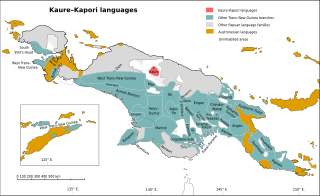Related Research Articles

Trans–New Guinea (TNG) is an extensive family of Papuan languages spoken on the island of New Guinea and neighboring islands, a region corresponding to the country Papua New Guinea as well as parts of Indonesia.

The Papuan languages are the non-Austronesian languages spoken on the western Pacific island of New Guinea, as well as neighbouring islands in Indonesia, Solomon Islands, and East Timor. It is a strictly geographical grouping, and does not imply a genetic relationship.

The East Geelvink Bay or East Cenderawasih languages are a language family of a dozen Papuan languages along the eastern coast of Geelvink Bay in Indonesian Papua, which is also known as Sarera Bay or Cenderawasih.
The Senagi languages are a small family of Papuan languages in the classification of Malcolm Ross, that had been part of Stephen Wurm's Trans–New Guinea proposal. They consist of the two languages Angor and Dera.
The Yuat languages are an independent family of five Papuan languages spoken along the Yuat River in East Sepik Province, Papua New Guinea. They are an independent family in the classification of Malcolm Ross, but are included in Stephen Wurm's Sepik–Ramu proposal. However, Foley and Ross could find no lexical or morphological evidence that they are related to the Sepik or Ramu languages.
The Yalë language, also known as Yadë, Nagatman, or Nagatiman, is spoken in northwestern Papua New Guinea. It may be related to the Kwomtari languages, but Palmer (2018) classifies it as a language isolate.
The Busa language, also known as Odiai (Uriai), is spoken in three hamlets of northwestern Papua New Guinea. There were 244 speakers at the time of the 2000 census. One of the hamlets where Busa is spoken is Busa in Rawei ward, Green River Rural LLG, Sandaun Province.
Amanab is a Papuan language spoken by 4,400 people in Amanab District, Sandaun Province, Papua New Guinea.
Duwet, also known as Guwot or Waing, is an aberrant member of the Busu subgroup of Lower Markham languages in Morobe Province, Papua New Guinea. Duwet is spoken by about 400 people and appears to have been heavily influenced by its neighboring Nabak language of the Papuan Trans–New Guinea languages. It is spoken in the three villages of Lambaip, Lawasumbileng, and Ninggiet.

Papua New Guinea, a sovereign state in Oceania, is the most linguistically diverse country in the world. According to Ethnologue, there are 840 living languages spoken in the country. In 2006, Papua New Guinea Prime Minister Sir Michael Somare stated that "Papua New Guinea has 832 living languages ."

The Kaure–Kosare or Nawa River languages are a small family spoken along the Nawa River in West Papua, near the northern border with Papua New Guinea. The languages are Kaure and Kosare.

The Yam languages, also known as the Morehead River languages, are a family of Papuan languages. They include many of the languages south and west of the Fly River in Papua New Guinea and Indonesian Western New Guinea.
Kaki Ae, or Tate, is a language spoken by about 500 people, half the ethnic population, near Kerema, in Papua New Guinea. It was previously known by the foreign designation Raeta Tati.
West Bird's Head languages are a small family of poorly documented Papuan languages spoken on the Bird's Head Peninsula of New Guinea.

Kaure is a Papuan language of West Papua. It is spoken in the villages of Lereh, Harna, Wes, Masta, and Aurina.
Orya is a Papuan language spoken in Indonesia. Warpok is the Nimboran name.
Yetfa and Biksi are dialects of a language spoken in Jetfa District, Pegunungan Bintang Regency, Highland Papua, Indonesia, and across the border in Papua New Guinea. It is a trade language spoken in Western New Guinea up to the PNG border.
Mandobo, or Kaeti, is a Papuan language of Mandobo District in Boven Digoel Regency, South Papua, Indonesia.
The Kwerbic, or Greater Kwerba, languages are a family of just under a dozen Papuan languages spoken in Indonesia.
The Northwest Papuan languages are a proposed language family of Papuan languages.
References
- 1 2 Nimboran at Ethnologue (18th ed., 2015) (subscription required)
- 1 2 Foley, William A. (2018). "The languages of Northwest New Guinea". In Palmer, Bill (ed.). The Languages and Linguistics of the New Guinea Area: A Comprehensive Guide. The World of Linguistics. Vol. 4. Berlin: De Gruyter Mouton. pp. 433–568. ISBN 978-3-11-028642-7.